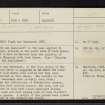Cladh Nan Sasunnach
Cemetery (17th Century)
Site Name Cladh Nan Sasunnach
Classification Cemetery (17th Century)
Canmore ID 12081
Site Number NH06NW 2
NGR NH 0070 6595
Datum OSGB36 - NGR
Permalink http://canmore.org.uk/site/12081
- Council Highland
- Parish Gairloch
- Former Region Highland
- Former District Ross And Cromarty
- Former County Ross And Cromarty
NH06NW 2 0070 6595.
(NH 0070 6595) Cladh nan Sasunnach (NAT).
OS 6"map, 2nd ed., Ross and Cromarty, (1905)
'Cladh nan Sasunnach' is the name applied to 'some cairns, situate on the north side of Loch Maree, about half a mile north-west from the junction of Abhainn an Fhasaigh with Loch Maree. Sig:- "Burying Ground of the Englishmen".
Name Book 1875
Cladh nan Sasunnach, on the flat ground at the head of Loch Maree is supposed to be where the iron- workers of Loch Maree were buried but they were probably buried on Isle Maree. The burials on the Cladh nan Sasunnach were probably much older. 'There are indications of twenty-four graves, all with the feet pointed towards the east, and all covered more or less with large unwrought stones. There are head and foot stones more or less distinct to all the graves. A number of the graves were opened but no trace of the burials was found.
J H Dixon 1886
Cladh nan Sasunnach, a close group of 21 roughly rectangular mounds, average size 2.0m x 1.5m x 0.5m high composed of large unhewn stones. They have the appearance of rude gravestones, and this tradition is still known locally.
Visited by OS (N K B) 31 March 1965
NH 011 654 Between August and November 1996 a programme of assessment, survey and excavation was undertaken around Loch Maree, Wester Ross, and specifically on the early 17th-century ironworks at Fasagh. The work focused on the assessment of previously identified ironworking sites, topographic survey, geophysical survey, excavations, and test-pits in support of the geophysics.
Cladh na Sasunnach
NH 0070 6595 A graveyard, situated 620m NW of the ironworks, was investigated to establish the relationship between iron-making centres, accompanying settlement and burial practices of the area. The cemetery is positioned on a small flat step of land made up of glacial gravels adjacent to Lochan Cladh nan Sasunnach. Excavation was targeted on one of the 23 graves identified and represented by angular boulder cairns. Very little of the coffin survived and there was no evidence of any organic/inorganic human remains. The only remnants of the coffin encountered were iron nails and a small waterlogged fragment of wood at the northern end. Comparison between the nails discovered with the coffin and those found at the ironworks shows very few similarities especially with relation to degree of corrosion. However, this could be due to the completely different pedological horizons from which they were recovered.
An interim report on this work will be lodged with the NMRS.
Sponsors: Historic Scotland, Letterewe Estate.
J A Atkinson, M Donnelly, J Duncan, O Lelong and E Photo-Jones 1997
Project (August 1996 - November 1996)
NH 011 654 Between August and November 1996 a programme of assessment, survey and excavation was undertaken around Loch Maree, Wester Ross, and specifically on the early 17th-century ironworks at Fasagh. The work focused on the assessment of previously identified ironworking sites, topographic survey, geophysical survey, excavations, and test-pits in support of the geophysics.
In August 1996 an assessment of the Loch Maree area was undertaken as the initial step in the fieldwork programme. In the case of the previously identified bloomery sites no evidence of iron production was noted. The blast furnaces on the other hand remain as impressive monuments. No new bloomery localities were located on the burns traversed. Additional information was recovered for the sites of Fasagh, Letterewe and Red Smiddy, including at Letterewe the presence of haematite ore, and at Red Smiddy and Fasagh the location of settlement possibly related to them and also further structural components of these ironworks.
NG 894 713 Site of Gharbaig, canalised burn, narrow curvilinear channel 15 x 0.2m.
An interim report on this work will be lodged with the NMRS.
Sponsors: Historic Scotland, Letterewe Estate.
J A Atkinson, M Donnelly, J Duncan, O Lelong and E Photos-Jones 1997
Unspecified Geophysical Survey Technique (August 1996 - November 1996)
NH 011 654 Between August and November 1996 a programme of assessment, survey and excavation was undertaken around Loch Maree, Wester Ross, and specifically on the early 17th-century ironworks at Fasagh.
Geophysical survey.
Sponsors: Historic Scotland, Letterewe Estate.
J A Atkinson, M Donnelly, J Duncan, O Lelong and E Photos-Jones 1997












